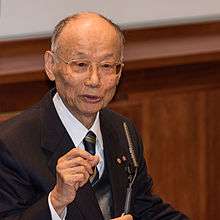Satoshi Ōmura
| Satoshi Ōmura | |
|---|---|
 Satoshi Ōmura, Nobel Laureate in medicine in Stockholm December 2015 | |
| Native name | 大村 智 |
| Born |
12 July 1935 Nirasaki, Yamanashi, Japan |
| Nationality | Japanese |
| Fields | Biochemistry |
| Institutions |
Kitasato University Wesleyan University |
| Alma mater |
University of Yamanashi Tokyo University of Science (M.S., Sc. D.) University of Tokyo (Ph.D.) |
| Academic advisors |
Koji Nakanishi Max Tishler |
| Known for | Avermectin and Ivermectin |
| Notable awards |
Japan Academy Prize (1990) Koch Gold Medal (1997) Gairdner Global Health Award (2014) Nobel Prize in Physiology or Medicine (2015) |
Satoshi Ōmura (大村 智 Ōmura Satoshi, born 12 July 1935) is a Japanese biochemist. He is known for the discovery and development of various pharmaceuticals originally occurring in microorganisms. In 2015, he was awarded the Nobel Prize in Physiology or Medicine jointly with William C. Campbell and Tu Youyou.
Education
Omura graduated from the University of Yamanashi, he received his M.S. degree from Tokyo University of Science and his Ph.D. in Pharmaceutical Sciences from the University of Tokyo and a Ph.D. in Chemistry at the Tokyo University of Science.[1]
Career
Satoshi Ōmura is professor emeritus at Kitasato University and Max Tishler Professor of Chemistry at Wesleyan University. He is known for the discovery and development of various pharmaceuticals originally occurring in microorganisms. He was awarded the 2015 Nobel Prize in Physiology or Medicine jointly with William C. Campbell and Tu Youyou for discoveries concerning a novel therapy against infections caused by roundworm parasites. More precisely, his research group isolated a strain of Streptomyces avermitilis that produce the anti-parasitical compound avermectin. Campbell later acquired these bacteria and developed the derived drug ivermectin that is today used against river blindness, lymphatic filariasis and other parasitic infections.[1][2][3]
Honors and awards
Scientific and academic
- 1985 – Hoechst-Roussel Award[4]
- 1986 – The Pharmaceutical Society of Japan Award[4]
- 1988 – Uehara Prize[4]
- 1990 – Japan Academy Prize (academics)[4]
- 1995 – Fujiwara Prize[4]
- 1997 – Robert Koch Gold Medal[5]
- 1998 – Prince Mahidol Award[4]
- 2000 – Nakanishi Prize (American Chemical Society and Chemical Society of Japan)[4]
- 2005 – Ernest Guenther Award in the Chemistry of Natural Products (American Chemical Society)[4]
- 2007 – Hamao Umezawa Memorial Award[4]
- 2010 – Tetrahedron Prize for Creativity in Organic Chemistry[4]
- 2011 – Arima Award[4]
- 2014 – Canada Gairdner Global Health Award[6]
- 2015 – Nobel Prize in Physiology or Medicine
National
- 1992 – Medal with Purple Ribbon[4]
- 2011 – Order of the Sacred Treasure, Gold and Silver Star[7]
- 2012 – Person of Cultural Merit[4]
Membership in learned societies
- 1992 – Academy of Sciences Leopoldina[8]
- 1999 – National Academy of Sciences[9]
- 2001 – Japan Academy[10]
- 2002 – Académie des sciences[11]
Other
- 2008 – Knight of the Legion of Honour of France
See also
References
- 1 2 "Satoshi Omura PhD". Retrieved 5 October 2015.
- ↑ http://www.nobelprize.org/nobel_prizes/medicine/laureates/2015/press.pdf
- ↑ "Japanese microbiologist Satoshi Omura shares Nobel Prize for medicine". The Japan Times. 5 October 2015. Retrieved 5 October 2015.
- 1 2 3 4 5 6 7 8 9 10 11 12 13 Satoshi Ōmura. "Satoshi Ōmura Curriculum Vitae" (PDF).
- ↑ "Robert Koch Gold Medal". Robert-Koch-Stiftung e.V. Retrieved 2015-10-05.
- ↑ http://www.gairdner.org/content/satoshi-omura
- ↑ 【政府】11年「春の叙勲」‐森田氏に旭重、大村氏が瑞重 薬事日報 2011年6月20日
- ↑ List of Members | Prof. Dr. Dr. Satoshi Ōmura
- ↑ Member Directory | Satoshi Omura
- ↑ Japan Academy membership profile
- ↑ Académie des sciences membership profile
External links
- Professor Satoshi Omura
- Satoshi Ōmura | People | THE KITASATO INSTITUTE
- Nirasaki Omura Art Museum
- Satoshi Ōmura Quotes With Pictures
